Key takeaways:
- Nutrient burn is primarily caused by over-fertilization and improper pH levels, highlighting the importance of balanced nutrient management.
- Signs of nutrient burn include yellowing leaf tips, browning edges, and stunted growth, signaling the need for immediate adjustment.
- Preventive measures include starting with diluted nutrient solutions, regular pH testing, and gradual increases in nutrient strength to avoid plant stress.
- Maintaining a consistent feeding schedule and closely observing plant health are essential for successful cannabis cultivation and nutrient management.
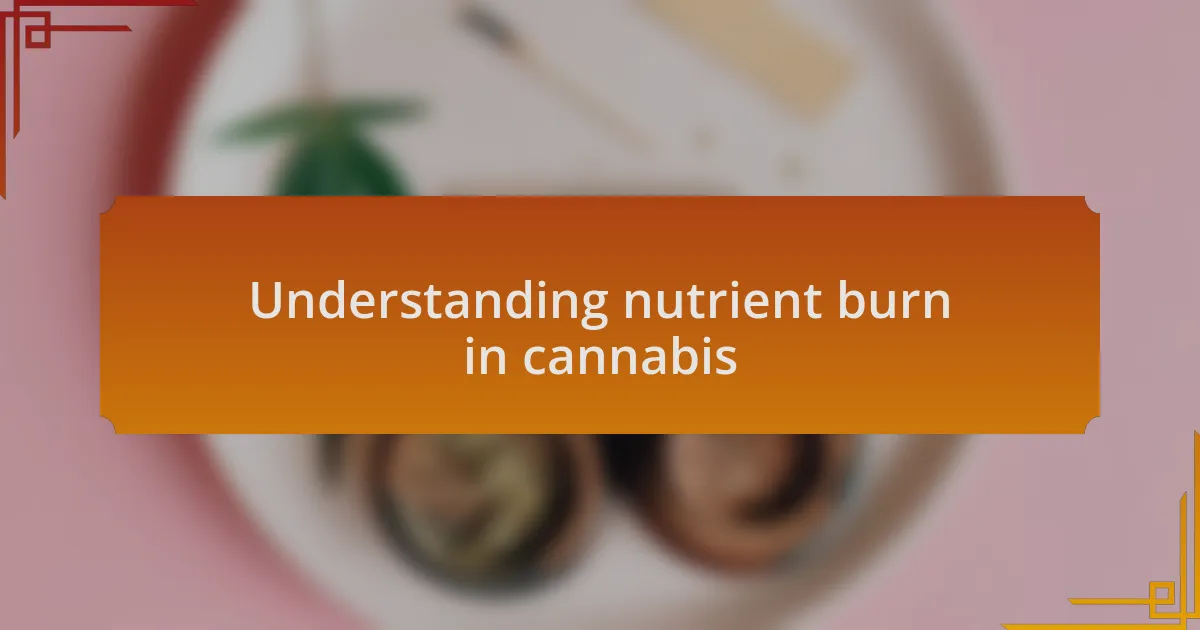
Understanding nutrient burn in cannabis
Nutrient burn is a common yet often misunderstood issue among cannabis growers. It’s not just about over-fertilizing; it’s about balance. I’ve witnessed firsthand how an excess of certain nutrients, especially nitrogen, can lead to leaf tips curling and turning brown, leaving growers scratching their heads. Have you ever felt that sinking feeling when you realize your plants are suffering because of your good intentions?
Noticing those first signs of nutrient burn can be disheartening for any cultivator. I remember when I first encountered it, I thought my plants were simply thirsty. It turned out that the high levels of nutrients I was giving them were artificially stressing them instead. Understanding the specific needs of your plants at various growth stages is crucial. Why is it that a plant can thrive one week and appear burnt the next?
It’s essential to regularly monitor your plants and adjust nutrient concentrations accordingly. I often keep a journal of my feeding schedule and the plants’ responses. This practice has helped me fine-tune my approach and prevent nutrient burn. What strategies have you found effective in nurturing your plants while avoiding this frustrating issue?
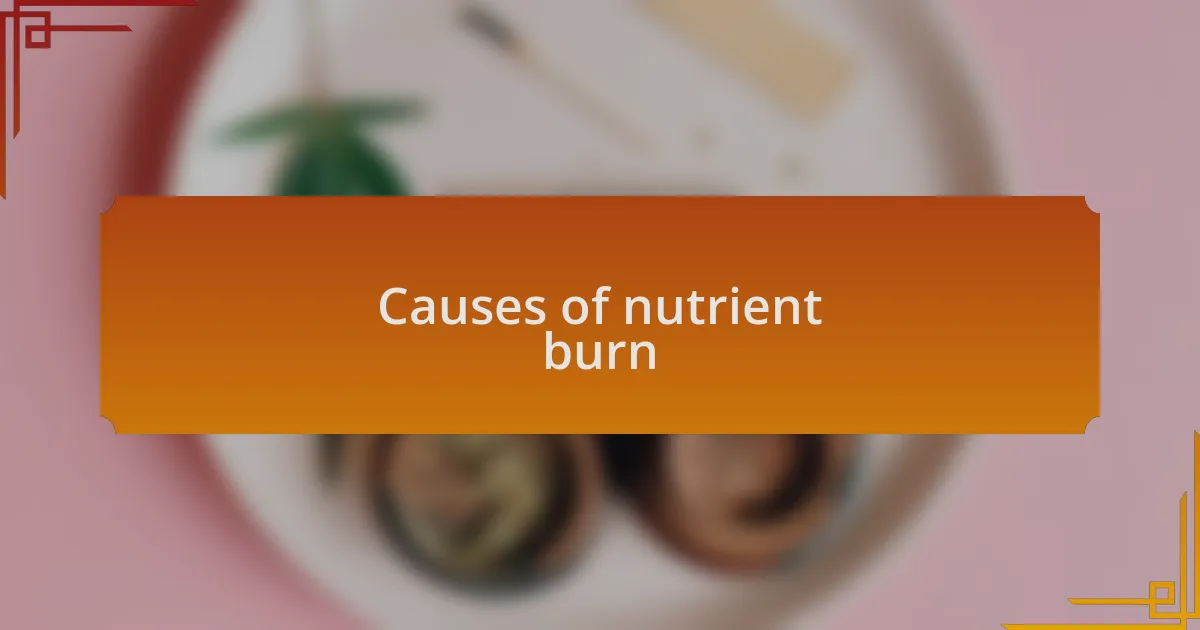
Causes of nutrient burn
Nutrient burn primarily stems from the over-application of fertilizers, often because growers want to give their plants the best nutrients available. I recall a time when I got excited about a new nutrient blend and unintentionally doubled the recommended dosage. The next thing I knew, my once-thriving plants were showing serious signs of distress. Have you ever felt that thrill of trying something new, only to watch it backfire?
Another significant factor contributing to nutrient burn is the plant’s inability to absorb nutrients efficiently, which can be influenced by pH levels in the soil or growing medium. I learned this the hard way after battling with nutrient burn for weeks, only to discover that my pH was way off. It was an eye-opening experience that taught me the importance of checking and adjusting pH regularly. How often do you consider the pH balance of your grow medium?
Environmental conditions also play a crucial role in nutrient uptake. High temperatures, poor airflow, or insufficient light can stress plants, making them more susceptible to nutrient burn even if you’re using the right amount of fertilizer. I remember a summer when my grow room overheated, and despite my careful feeding, the plants showed signs of burn. It made me realize that all aspects of cultivation are interconnected, prompting me to reevaluate my entire setup. What environmental factors are you keeping an eye on in your growing space?
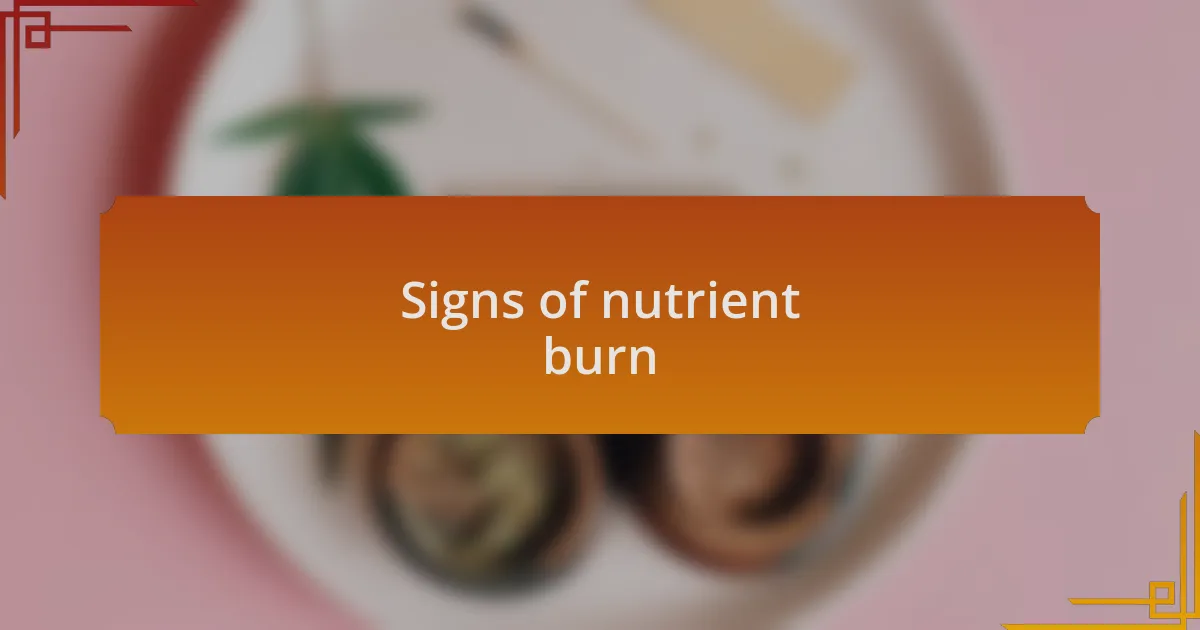
Signs of nutrient burn
One of the first signs of nutrient burn you’ll notice is the appearance of yellowing leaves, particularly at the tips. I vividly remember walking into my grow room one day only to be greeted by a sea of curled, yellowing tips. It was a stark reminder that plants can only take in so much before they start to show distress. Have you ever experienced that sinking feeling when you realize your plants aren’t thriving?
As the situation worsens, you might see browning or crispy leaf edges, which further indicates nutrient overload. In my own experience, I watched in dismay as some of my once-lush leaves turned crisp to the touch, a sure sign that my plants were long overdue for a nutrient reset. It really makes you think about the balance needed in plant care—how do we learn to listen to what our plants are saying?
Additionally, nutrient burn can lead to stunted growth, which might leave you scratching your head. I remember nurturing a batch of plants that just wouldn’t grow, despite my attempts to provide optimal care. Eventually, it dawned on me that I had been so focused on feeding them nutrients that I neglected to check if they were actually able to use them effectively. If you’ve ever felt the frustration of watching your plants stagnate, you can probably relate to this lesson.
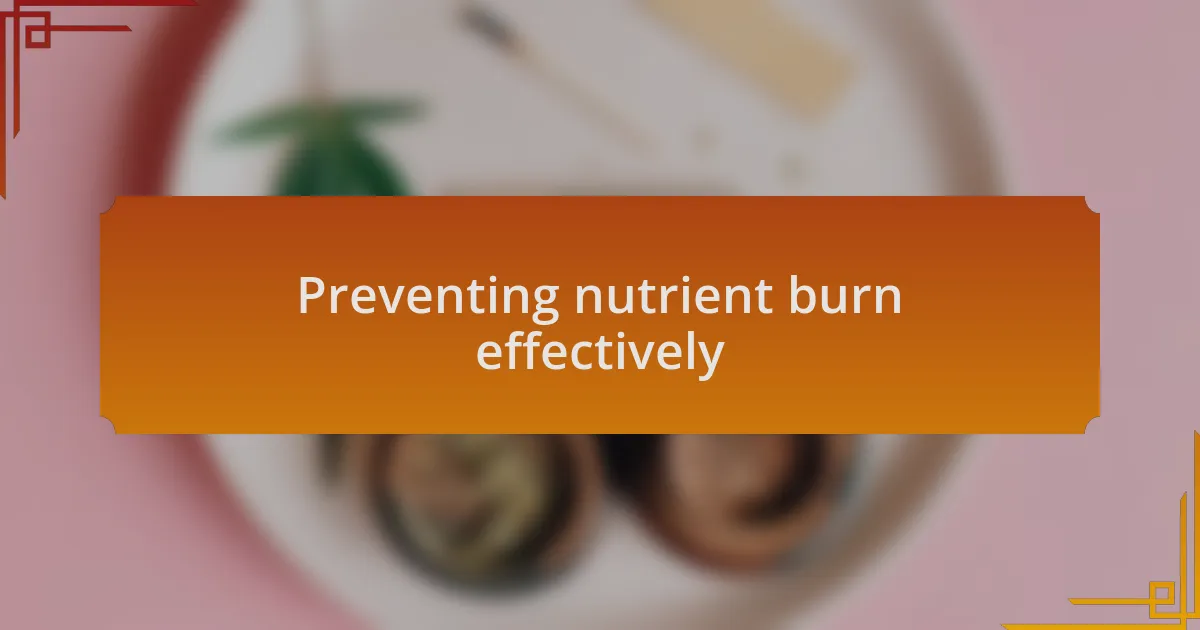
Preventing nutrient burn effectively
When it comes to preventing nutrient burn, it’s crucial to adopt a cautious approach to feeding your plants. I’ve found that starting with a diluted nutrient solution can often save you from the heartache of over-fertilization. Imagine the relief of watching your plants thrive without the stress of yellowing leaves—it’s truly rewarding.
Regularly testing your soil or nutrient solution is another effective strategy. Once, after experiencing a bout of nutrient burn, I invested in a pH meter, which became a game changer for me. Understanding the nutrient availability at different pH levels opened my eyes to how easily plants can become overwhelmed. Have you checked your pH levels lately?
Finally, the importance of gradually increasing nutrient strength cannot be overstated. I remember once making the mistake of jumping to full-strength nutrients right away. The results were disastrous! After that experience, I realized that providing nutrients incrementally not only allows the plants to adjust but also builds my confidence as a grower. What have you discovered about your plants’ nutrient preferences?
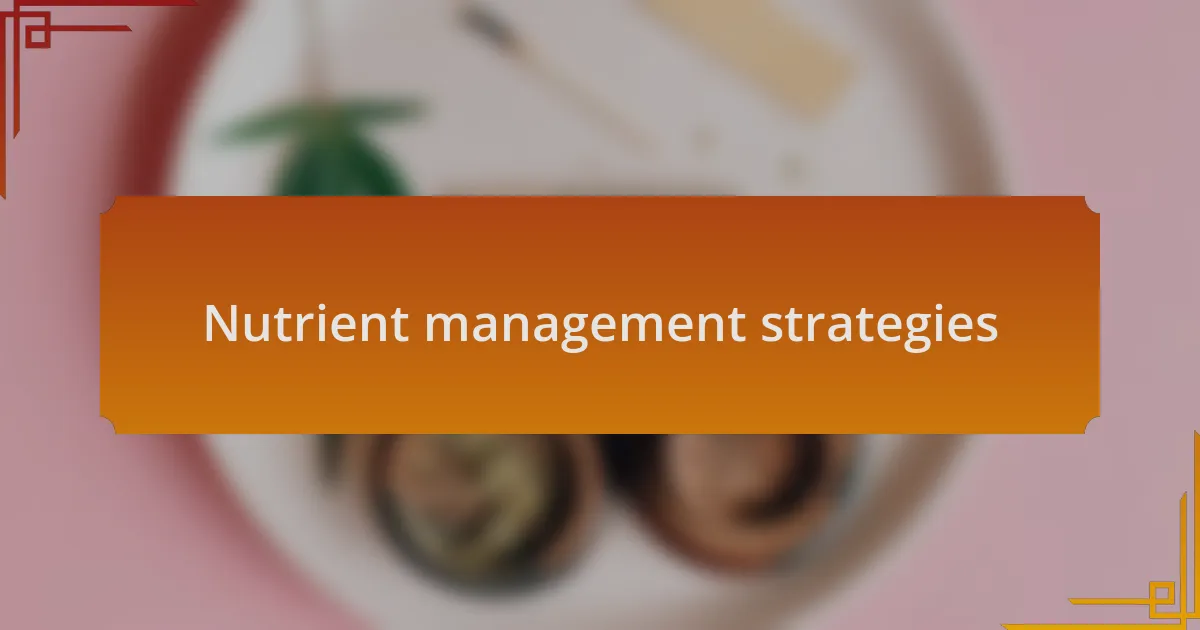
Nutrient management strategies
When managing nutrients, I’ve learned that maintaining a consistent feeding schedule plays a vital role. I once experimented with sporadic feedings, thinking it would allow my plants to “breathe” between nutrients. However, that led to uneven growth and confusion on my part when it came to determining what my plants really needed. Have regular intervals worked for you?
Another strategy that I’ve found effective is observing your plants closely. There was a time when I overlooked subtle signs of stress, mistaking them for normal growth variations. Now, I take the time to monitor the color and texture of the leaves, as these can offer clues about whether I’m on the right track with nutrient management. Have you ever dismissed a warning sign only to regret it later?
Furthermore, considering the use of organic nutrients can also mitigate the risk of nutrient burn. After transitioning to organic options, I noticed a remarkable difference in how my plants responded. They seemed more vibrant and resilient. It just goes to show that sometimes, less is more when it comes to feeding our green companions. What kind of nutrients have you found work best for your plants?
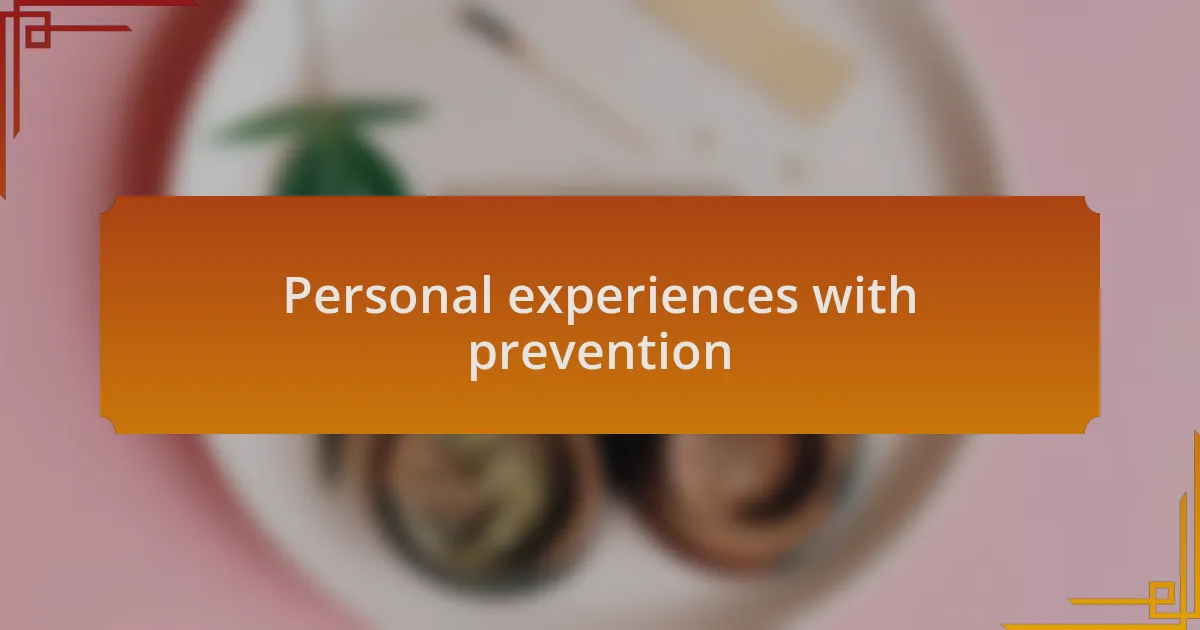
Personal experiences with prevention
I’ve often witnessed firsthand how simple adjustments can make a big difference in preventing nutrient burn. There was one occasion where I decided to dilute my nutrient solution after noticing the tips of my leaves starting to yellow. The relief I felt when my plants bounced back was a reminder of just how crucial it is to listen to what they’re saying through their growth patterns. Have you had a moment where a slight change paid off in a big way?
Another time, I learned the hard way the importance of pH levels in preventing nutrient lockout and burn. I recall a friend advising me to check the pH regularly, but I brushed it off. Once, I discovered that my pH was way off, leading to a surprising drop in health. That experience taught me that ignoring certain details can lead to significant missteps. Have you ever been caught off guard by an aspect of plant care you overlooked?
Lastly, I’ve found that regular flushing can be a game-changer. I remember a grow cycle where I neglected this step, thinking it wouldn’t matter much. The plants showed signs of nutrient burn in the later weeks, which left me feeling frustrated. Since then, I’ve prioritized flushing my plants periodically, and it’s been incredibly rewarding. Have you experienced the difference that flushing can make in the final weeks of growth?
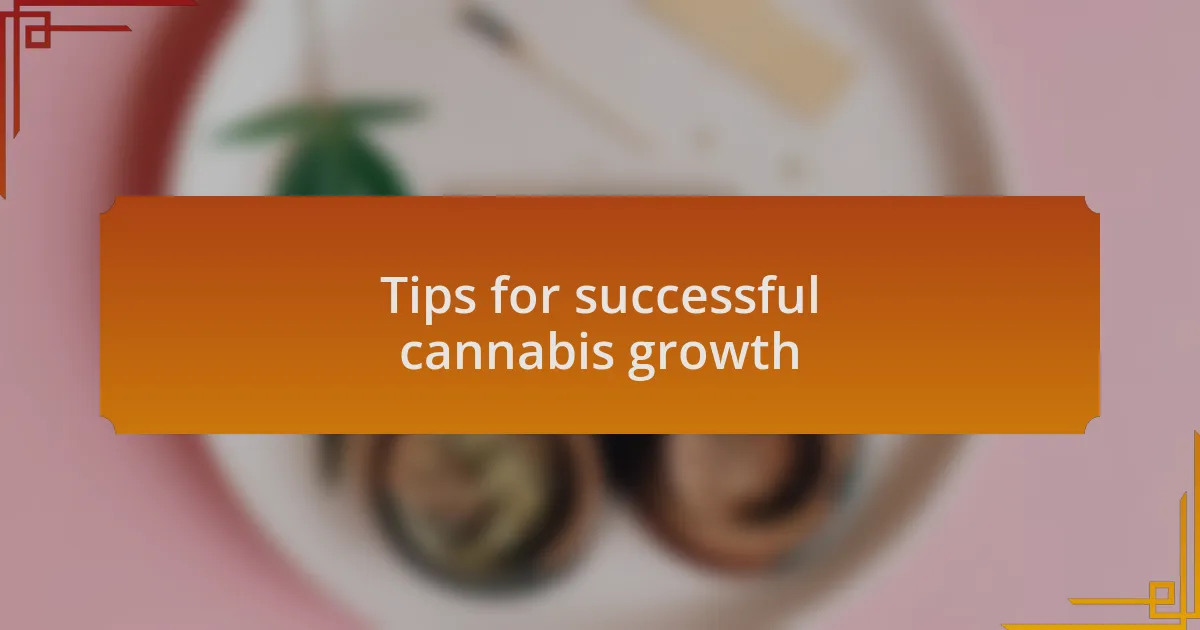
Tips for successful cannabis growth
When it comes to successful cannabis growth, I’ve found pay close attention to light levels is vital. I remember a grow where I was eager to maximize yields, so I cranked up the lights without considering how close they were to the plants. The result? A few scorched leaves and stunted growth. It made me realize that finding the right balance can significantly influence not just growth, but the overall health of my plants. Have you ever had to adjust your lighting to keep your plants thriving?
Another critical tip is to maintain a consistent watering schedule. I used to overwater, thinking more would guarantee a healthier plant. Once, after a weekend trip, I returned to find my plants drooping and struggling to recover. This taught me that consistency is key—understanding when and how much to water can lead to much better outcomes. Isn’t it interesting how small changes in routine can yield big differences in plant health?
Lastly, I’ve learned that building a solid nutrient plan tailored to the specific strain can work wonders. On one occasion, I used a one-size-fits-all approach, and my plants showed signs of nutrient deficiencies. After that, I took the time to research and adjust my nutrient feed based on their individual needs. This personalized attention made a noticeable difference in growth rate and vibrancy. Have you ever tailored your nutrient strategy, and how did that impact your plants?